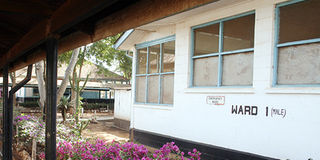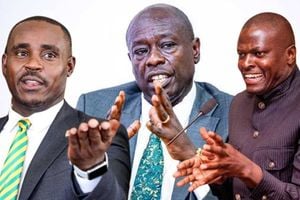Mystery of patient executed in Kenyan hospital

Ward One at the Makindu District Hospital where a gunman shot dead a patient who was in critical condition after surviving an earlier attack. Photo/CHRIS OJOW
More details have emerged about the mysterious execution of a patient as he lay unconscious in Makindu District Hospital, in Kenya's Eastern Province on Sunday night.
The gunmen entered the hospital's ward pretending to be relatives seeing a patient, according to patients and witnesses.
Two of them entered the hospital wearing masks while a third remained in a white get-away car. One of the killers stood guard at the door of Ward 1 while another walked straight to the patient and stood at his bedside.
He asked another patient in a nearby bed to close his eyes; then he aimed a pistol at his target and fired twice, shooting him in the neck and head.
His accomplice, who was keeping watch, whispered to the watchman to keep quiet. After the shooting, the attackers walked away calmly... and the killer still had the pistol in his hand. Once at the hospital parking, the two killers got in their car and drove away.
A witness, whom the Nation agreed not to name so as not to endanger his life, yesterday said the killing happened a few minutes before 7 pm.
But he said he remembered seeing one of the gunmen in the hospital at around 5pm, some six hours after the patient was admitted.
The patient, whose identity was unknown at the time of going to press, had been found on Saturday morning unconscious by the roadside near Tsavo National Park, with cuts in the head and neck, together with the bodies of four men. The bodies also had cuts in the neck and head.
A medical officer who the Nation agreed not to name for his own safety said the patient’s injuries were “very severe”. The man had been thought dead and was brought to the hospital together with the bodies by a vehicle from Mtito Andei Police Station.
A doctor who received the bodies discovered that one man was still alive and admitted him. The doctor said the man was “breathing spontaneously... but the injuries were severe because the skull was fractured and he had lost a lot of blood.”
When the gunmen walked in and killed him, the nurses were preparing to resuscitate him, said the doctor. The hospital wanted to stabilise the patient and then transfer him to Kenyatta National Hospital for specialised treatment.
Hospital authorities said they suspected the gunmen came to the hospital after the news of the Tsavo incident was aired in the media, reporting that one of the victims had survived.
Shocked hospital staff said the killers first entered the hospital at 5 pm when it opens it doors to visitors checking on their relatives.
At the casualty department, one of the gunmen even offered to help a nurse wheel an elderly patient, who had just been admitted, to the ward.
He is believed to have used the chance to look over the 21 patients admitted in the male ward and identify the man they wanted to kill.
When they returned, they wore black face masks but witnesses who had seen them earlier recognised them from their clothes. The killer wore a black leather jacket, a white shirt and a black leather cap. He was bulky and about six feet tall.
Before the attackers left Makindu, their car pulled over at a nearby petrol station for refuelling. They paid Sh1,000, a watchman told the Nation.
A motorcyclist who had been at the hospital’s parking at the time of the shooting also said he saw the gunmen’s car at the petrol station.
Inflict injuries
The patient was booked in at the hospital as “unknown African male adult”. The doctor who examined his injuries shortly after admission said a lot of force had been used to inflict the injuries.
He estimated the patient’s age to be around late 20s or early 30s, the same age as three of the other victims. The fifth appeared to be in his late teens. All had fractured skulls, a pointer to the brutality of their killers.
Police reports said the five men were criminals, killed by a rival gang, a conclusion arrived at even before the identity of the victims could be established.




